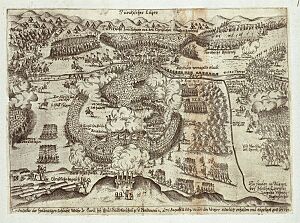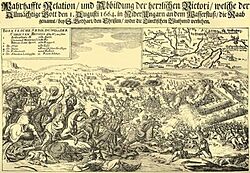Battle of Saint Gotthard (1664) facts for kids
Quick facts for kids Battle of Saint Gotthard |
|||||||
|---|---|---|---|---|---|---|---|
| Part of the Austro-Turkish War (1663–1664) | |||||||
 Battle of Saint Gotthard |
|||||||
|
|||||||
| Belligerents | |||||||
|
|||||||
| Commanders and leaders | |||||||
| Raimondo Montecuccoli Johann von Sporck Margrave von Baden Comte de Coligny Prince Waldeck |
Köprülüzade Fazıl Ahmed Pasha | ||||||
| Strength | |||||||
| ~26–28,000, 30,000 or 40,000 | ~50,000–60,000 (30,000 remained unengaged)
Total: 150,000 ~60,000 janissaries, and sipahi 60–90,000 irregular |
||||||
| Casualties and losses | |||||||
| 2,000 | 8,000–10,000
14,000–22,000 |
||||||
The Battle of Saint Gotthard was a major fight during the Austro-Turkish War (1663–1664). It happened on August 1, 1664, near the Raab River in what is now Hungary. This battle saw the Holy Roman Empire's forces, including soldiers from Germany, Sweden, and France, face off against the powerful Ottoman Empire's army.
The Imperial forces were led by Count Raimondo Montecuccoli. The Ottoman army was under the command of Köprülüzade Fazıl Ahmed Pasha. The Ottomans were trying to push through Hungary towards Vienna, the capital of the Habsburg monarchy. However, they were stopped at the Raab River. The Imperial forces attacked and defeated them.
After this important victory, the Ottomans signed a peace treaty called the Peace of Vasvár just a week later. Even though the Ottomans lost the battle, the treaty was not very good for the Holy Roman Empire. This surprised many in Europe and even upset some Hungarian nobles, which later led to a plot against the Emperor.
Contents
Why the Battle Happened
The Ottoman Empire had a strong presence in Hungary since the Battle of Mohács in 1526. This battle led to the Ottomans taking over much of Hungary. The parts of Hungary that remained free were controlled by the Austrian Habsburgs.
For a while, the Ottoman Empire wasn't as strong. But then, the very skilled Köprülü family came to power. They wanted to defeat the Austrian Habsburgs for good. They found a reason to start a war when the Habsburgs supported a rebellion in Transylvania against Ottoman rule.
Transylvania was a region that had managed to stay independent. It did this by balancing its powerful neighbors: Poland, Austria, and the Ottomans. Transylvania paid a tribute to the Ottomans but kept its own government and religion.
In 1658, Prince George II Rákóczi of Transylvania invaded Poland. He did this with his Swedish allies during the Second Northern War. After some early success, he was defeated and had to flee back to Transylvania. The Ottomans were angry about Rákóczy's war because he didn't have their permission. They declared war on Transylvania.
The Ottoman Grand Vizier, Köprülü Mehmed Pasha, quickly defeated Rákóczy. He then conquered Transylvania. The new Transylvanian prince, János Kemény, ran to Vienna to ask Austria for help.
Emperor Leopold I didn't want Transylvania to fall completely under Ottoman control. So, he sent Montecuccoli with his small army into Hungary. But Montecuccoli's army was much smaller than the Ottoman forces, so he couldn't offer direct help. The Ottomans continued to conquer Transylvania and built up their army in Ottoman-controlled Hungary. Leopold I knew he couldn't fight the Ottomans alone. He called a meeting of the Imperial Diet (a kind of parliament) in January 1663 to get support.
The Ottomans tried to capture the fortress of Nové Zámky six times without success. But in 1663, they finally took it. They made it the center of a new Ottoman province. In 1663, large numbers of Turkish and Tatar soldiers crossed the Danube River. They attacked and took 12,000 slaves in Moravia. Some Turkish groups even reached as far as Olomouc.
Getting Ready for Battle
Even though Emperor Leopold I didn't like Protestantism, he needed help from his Protestant German princes. He also needed help from France, which was usually Austria's enemy. Despite some disagreements, help arrived.
The League of the Rhine, a group of German princes led by France, sent 6,000 soldiers. These troops were commanded by Count Coligny of France and Prince Johann Philipp of Mainz. By September 1663, Brandenburg and Saxony also promised to send their own soldiers. In January 1664, the Imperial Diet agreed to raise 21,000 men. However, this army only existed on paper at that time. The Turks had declared war in April 1663, but they were slow to start their invasion.
The Battle Begins
The Ottoman army, led by Köprülü, was huge. It might have had between 120,000 and 150,000 soldiers. This included about 60,000 elite Janissaries and sipahis, plus many other soldiers like azaps, akıncıs, silidars, Tatars, and soldiers from other countries. They also had around 360 cannons.
Montecuccoli's army was much smaller. It was made up of soldiers from different places:
- Habsburg forces: 5,000 foot soldiers, 5,900 cavalry (horseback soldiers), and 10 cannons. This included Czech infantry and some Hungarians and Croatians.
- Imperial forces: 6,200 foot soldiers, 1,200 cavalry, and 14 cannons.
- Rhine forces: 600 foot soldiers, 300 cavalry.
- French forces: 3,500 foot soldiers, 1,750 cavalry.
- Other forces: 2,000 Croatian cavalry, Hungarian foot soldiers, Czech musketeers, and an Italian infantry regiment.
The Turks started their invasion again in the spring of 1664. In early July, they attacked and destroyed the Novi Zrin Fortress in northern Croatia. Montecuccoli was still waiting for more help to arrive. This delay was very important for Austria's defense.
By July 1664, the Imperial forces had gathered. They marched to the Raab River, which separated the Ottoman army from Austria. If the Turks crossed the river, they would threaten both Vienna and Graz. Montecuccoli stopped the Turks before they could cross. However, the different commanders in his army made it hard to organize the troops effectively.
On August 1, 1664, Ottoman forces managed to cross the river near the monastery of Saint Gotthard. They pushed the Austrians back. At first, there was a lot of confusion among Montecuccoli's allies. But he finally convinced Coligny and Leopold Wilhelm of Baden-Baden (who led the Imperial soldiers) to combine their forces. They then attacked the Ottoman troops, who were regrouping in a nearby forest.
The attack surprised the Turks. They ran back to the river in confusion, and many of them drowned. The chaos caused by the fleeing soldiers stopped Ahmed Köprülü from sending the rest of his army across the river. He decided to retreat from the battlefield.
The Ottomans suffered heavy losses, especially among their best soldiers. Köprülü was left with an army of less trained soldiers. Montecuccoli's army had fewer losses, mostly among the Imperial troops.
What Happened Next
Many people in Europe, especially the Croats and Hungarian nobles, hoped that the Austrian Habsburgs would finally free Hungary from Ottoman rule. However, Emperor Leopold decided to end the campaign. Many people have criticized him for this choice.
Even though Montecuccoli's army was mostly fine, the allies were not interested in freeing Hungary. Any invasion of Hungary would likely have to happen without the help of the French and German soldiers. Leopold also noticed that the French officers were becoming friendly with the Hungarian nobles. They were even encouraging them to rebel against Austrian rule.
Also, Leopold was part of the "Spanish group" in Vienna. The last Spanish Habsburg king, Carlos II, was very sick and expected to die soon. Leopold wanted to be ready for the fight against Louis XIV of France that would surely follow. Even though freeing Hungary was important for the Habsburgs, it had to wait. Throughout his time as emperor, Leopold was always more focused on fighting France than the Ottomans.
Because of this, he signed the Peace of Vasvár, which was not a very good deal for the Holy Roman Empire. This treaty didn't really reflect the victory at Saint Gotthard. However, the Battle of Saint Gotthard was still very important. It stopped any Ottoman invasion of Austria. This would have made the war much longer and led to a terrible outcome. The Austrians also used the twenty-year peace to build up their army. This helped them start freeing Hungary in 1683.
In Books and Poems
The Battle of Mogersdorf/Szentgotthárd inspired the famous writer Rainer Maria Rilke. He wrote a poetic short story called "Lay of the Love and Death of Cornet Christopher Rilke." This story was very popular among German and Austrian soldiers in the early 1900s.
See also
- Louis XIV Victory Monument
- Battle of Saint Gotthard (1705)





